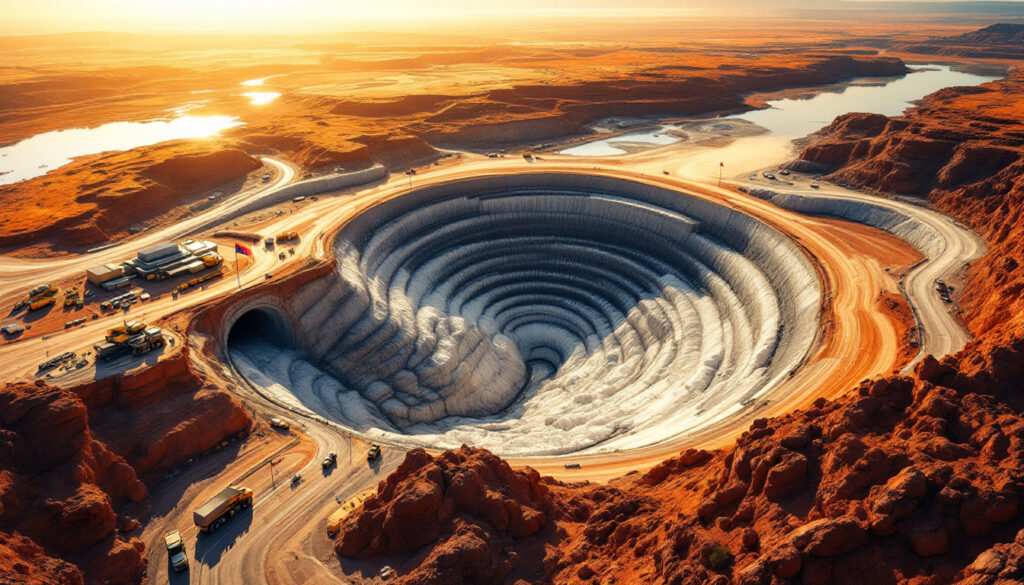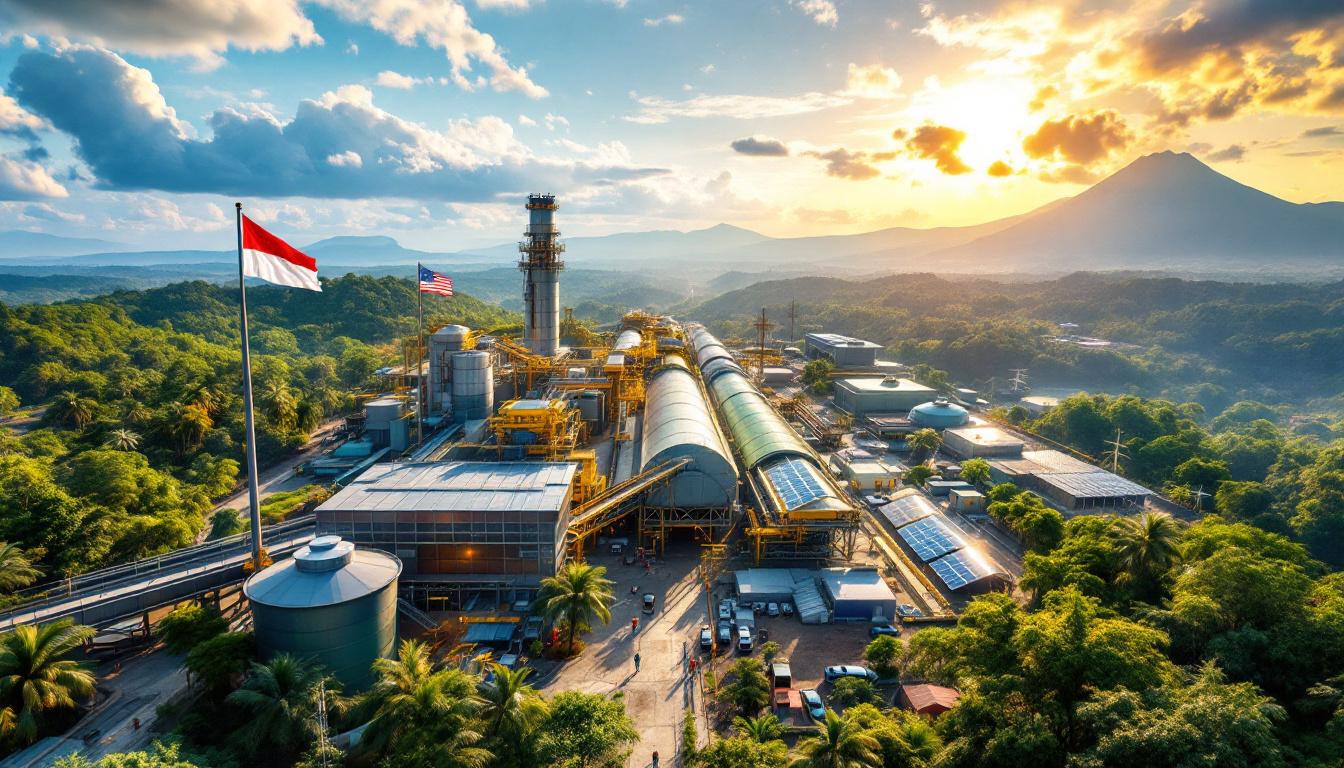Understanding Core Lithium's Major Resource Upgrade
Core Lithium has achieved a remarkable milestone in the evolution of its Finniss lithium project, located in Australia's Northern Territory. The company recently announced a substantial expansion of both mineral resources and ore reserves, positioning it for extended production capabilities and strengthening its presence in the rapidly growing global lithium market.
The updated figures reveal impressive growth across the project. According to Core Lithium's ASX announcement, the total Finniss ore reserve has increased to 10.73 million tonnes at 1.29% Li₂O, representing a significant expansion over previous estimates. This comprehensive reserve upgrade supports Core Lithium's revised operating strategy, which includes transitioning from purely open-pit operations to a combination of open-pit and underground mining methods.
The total mineral resource estimate now stands at a substantial 48.5 million tonnes at 1.26% Li₂O, including 310,000 tonnes of tailings and coarse rejects at 0.66% Li₂O. This holistic approach to resource accounting demonstrates the company's commitment to maximizing value from all available material at the Finniss project site.
"The updated ore reserve reflects our revised operating strategy for the Finniss Lithium Project and highlights the significant resource across our broader tenement package," noted Paul Brown, Core Lithium CEO. "These results support at least the first ten years of production at Finniss, with exploration targets suggesting potential for a much longer mine life."
The technical shift to underground mining methods, particularly long hole open stoping combined with paste backfill technology, aligns with industry best practices seen at other major lithium operations globally. Similar approaches have been successfully implemented at world-class operations like Greenbushes (Talison Lithium), where sub-level open stoping has proven effective for extracting high-grade lithium ore bodies while minimizing dilution.
When compared to other Australian lithium industry innovations, Finniss represents a significant resource base, though it remains smaller than industry giants like Pilbara Minerals' Pilgangoora (413Mt at 1.14% Li₂O). However, the high-grade nature of Core Lithium's deposits, particularly at Blackbeard and BP33, positions the company favorably in terms of potential extraction economics.
What Are the Key Reserve Improvements at Finniss?
Grants Open Pit Reserve Doubles
One of the most significant developments in Core Lithium's reserve update is the doubling of the Grants open pit ore reserve, which has increased by 100% to 1.15 million tonnes from its previous estimate of 0.575 million tonnes. This substantial growth forms a critical part of the company's strategic shift at Finniss, which includes plans to transition from open pit to underground mining methods at the Grants deposit.
The reserve expansion at Grants provides Core Lithium with greater operational flexibility and resource certainty during the transition period. According to the company's technical assessment, the underground transition is expected to unlock additional material at deeper levels while simultaneously reducing operational costs through more efficient extraction methods.
BP33 Reserve Growth
The BP33 deposit has emerged as the cornerstone of the Finniss project, with its reserve growing to an impressive 9.29 million tonnes. This substantial figure contributes the lion's share to the total Finniss ore reserve of 10.73 million tonnes at 1.29% lithium oxide (Li₂O).
The enhanced understanding of the BP33 deposit's geometry and grade distribution has enabled Core Lithium to significantly increase confidence in the resource. This comprehensive reserve increase supports the company's long-term production strategy and positions Finniss as a significant contributor to Australia's lithium supply chain for at least the next decade.
A key benefit of the underground approach at both Grants and BP33 will be the dramatic reduction in strip ratios compared to traditional open-pit methods. While open-pit lithium mines typically operate with strip ratios between 3:1 and 5:1 (waste to ore), underground operations can achieve ratios approaching 1:1 or better, substantially improving operational economics over the life of mine.
Similar optimization strategies have been successfully implemented at other Australian lithium operations, including Allkem's Mt Cattlin project, which achieved significant cost reductions through pit optimization as reported in their FY2023 financial results.
How Will Underground Mining Transform Finniss Operations?
Mining Method Innovations
Core Lithium's strategic shift to underground mining will incorporate sophisticated extraction techniques tailored to the specific characteristics of the Finniss lithium deposits. The company plans to implement long hole open stoping methods at both the Grants and BP33 deposits, a technique well-suited to the steeply dipping, relatively wide ore bodies typical of pegmatite-hosted lithium deposits.
At BP33, the mining approach will be further enhanced through the implementation of paste backfill technology, which involves mixing tailings with cement to create a structural filling material. This advanced technique offers multiple benefits:
- Improved geotechnical stability in underground workings
- Reduced surface tailings storage requirements
- Enhanced recovery of ore by allowing mining of adjacent pillars
- Minimized dilution of the high-grade lithium ore
According to mining industry data from CRU Group (2024), underground mining operations utilizing these AI in mining operations can achieve cost reductions of 20-30% compared to equivalent open-pit operations, particularly when accessing deeper, higher-grade material.
"Paste backfill technology represents best practice in modern underground mining, improving geotechnical stability while simultaneously reducing surface waste disposal requirements," explains a mining engineer from the Association of Mining and Exploration Companies (AMEC). "It's particularly advantageous for high-value mineral deposits like lithium, where minimizing dilution is critical to economic success."
Operational Benefits
The transition to underground mining at Finniss is expected to deliver multiple operational advantages that collectively enhance the project's economics and sustainability profile:
-
Access to deeper, higher-grade material – Underground methods allow Core Lithium to target extensions of the high-grade portions of both deposits that would be uneconomical to extract via open pit methods.
-
Reduced surface disturbance – Underground mining significantly reduces the project's physical footprint compared to expanded open pit operations, minimizing environmental impact and rehabilitation requirements.
-
Lower strip ratios and waste production – By directly accessing the ore body underground, the company eliminates the need for extensive overburden removal, dramatically improving the waste-to-ore ratio.
-
Improved selectivity and grade control – Underground mining enables more precise extraction of the high-grade zones within the pegmatite bodies, potentially increasing the average mill feed grade.
-
Enhanced safety through modern methods – Contemporary underground mining techniques incorporate extensive ground control measures and remote operations that can improve safety outcomes compared to traditional methods.
Similar integrated mining approaches have proven successful at operations like Newmont's Cadia Valley, where paste backfill enables the recycling of approximately 90% of tailings materials back into underground workings, demonstrating both the technical feasibility and environmental benefits of the approach.
What Does the Updated Mineral Resource Include?
Comprehensive Resource Expansion
Core Lithium's updated mineral resource estimate represents a holistic assessment of the Finniss project's lithium endowment. The total mineral resource now stands at 48.5 million tonnes at 1.26% Li₂O, reflecting both the company's successful exploration activities and a more comprehensive approach to resource classification.
A notable aspect of the updated resource is the inclusion of 310,000 tonnes at 0.66% Li₂O from tailings and coarse rejects, now classified as indicated resources. This progressive approach to resource utilization aligns with growing industry trends toward circular economy principles in mining, as highlighted by the International Council on Mining and Metals (ICMM, 2023). By incorporating previously overlooked materials into the resource base, Core Lithium demonstrates a commitment to maximizing value extraction while minimizing waste.
The resource update reflects continued refinement of geological models through extensive drilling and sampling programs, with classification according to the JORC (2012) Code standards. The indicated resource classification signifies that the quantity, grade, and mineral content can be estimated with a reasonable level of confidence, based on sampling information with locations spaced closely enough to confirm geological and grade continuity.
Exploration Upside Potential
Beyond the established resource base, Core Lithium has identified significant exploration targets that could substantially extend the Finniss project's production timeline. The company has outlined an exploration target of 10.9 to 16.5 million tonnes at grades of 1.5-1.7% Li₂O across the BP33 and Blackbeard prospects.
The Blackbeard prospect has emerged as a particularly promising growth opportunity, with exploration drilling intercepting a remarkable 63 meters at 1.67% Li₂O. This high-grade, thick intersection highlights the potential for Blackbeard to develop into a significant deposit within the Finniss project area. For context, this grade exceeds the global average lithium pegmatite grade of approximately 1.2% Li₂O, positioning it as a potentially premium resource.
Core Lithium has already initiated active drilling programs to test these targets, with the explicit goal of extending Finniss's mine life beyond the currently envisioned 10-year production plan. The company's systematic approach to exploration includes:
- Targeted diamond drilling to define resource extensions
- Detailed structural mapping to understand pegmatite emplacement
- Advanced geophysical techniques to identify blind pegmatite bodies
- Implementation of advanced 3D geological models to optimize future drill targeting
The exploration program benefits from the company's growing understanding of the regional controls on pegmatite emplacement, potentially accelerating the conversion of exploration targets to defined resources in coming drilling campaigns.
What Does This Mean for Core Lithium's Future?
Production Longevity
The substantially expanded reserves and resources at Finniss provide Core Lithium with a solid foundation for extended operations. The updated figures now underpin a minimum 10-year production timeline, assuming the planned processing capacity. This longevity is critical in the lithium sector, where consistent supply capability is increasingly valued by downstream customers in the battery and electric vehicle manufacturing chains.
The exploration targets identified at BP33 and Blackbeard suggest considerable potential for extending operations well beyond the initial decade. If successfully converted to resources and reserves, these targets could potentially add several additional years to the mine life, enhancing the overall project economics through extended utilization of infrastructure and processing facilities.
This extended operational horizon aligns with global lithium demand projections, which according to Benchmark Mineral Intelligence (2025) anticipate a compound annual growth rate (CAGR) of approximately 20% through 2030, driven primarily by electric vehicle battery manufacturing requirements. Core Lithium's timing positions the company to benefit from this sustained demand growth.
Market Positioning
With the significant resource upgrade, Core Lithium is strengthening its position as a notable Australian lithium producer in an increasingly competitive global market. The company is strategically focusing on delivering low-cost, high-quality lithium concentrate to global markets, with particular emphasis on the growing Asian battery manufacturing sector.
"Australian spodumene producers remain key to meeting the growing lithium demand driven by EV battery production," noted a UBS analyst in a recent Reuters interview (April 2025). "Companies with established resources, processing capabilities, and clear paths to production expansion are particularly well-positioned."
Core Lithium's strategic advantages include:
- Proximity to Asian markets – The Northern Territory location offers logistical advantages for export to key Asian battery manufacturing hubs
- Existing regulatory approvals – All major permits are in place, facilitating rapid production restarts and potential expansions
- High-grade resource – The 1.29% Li₂O reserve grade positions Finniss in the upper tier of global hard rock lithium projects
- Processing solutions – Planned plant upgrades targeted at improving recoveries and concentrate quality
While the company has not publicly disclosed specific offtake agreements, industry analysts suggest that Core Lithium is well-positioned to secure long-term supply contracts with major battery manufacturers and EV producers seeking diversified lithium supply chains.
How Does This Development Impact Australia's Critical Minerals Sector?
Strategic Resource Development
Core Lithium's resource expansion at Finniss reinforces Australia's position as a key supplier in the global lithium value chain. Australia currently produces approximately 55% of global lithium supply according to USGS (2024) data, with Western Australia traditionally dominating production. Core Lithium's development in the Northern Territory represents important geographic diversification within Australia's lithium sector.
The Finniss project contributes to Australia's critical minerals security objectives as outlined in the Australian Government's Critical Minerals Strategy (2023), which emphasizes the importance of developing domestic resources to support both national interests and global clean energy transitions. By bringing additional lithium resources into production, Core Lithium supports broader policy goals of positioning Australia as a reliable, ethical supplier of materials essential to decarbonization technologies.
From an economic perspective, lithium projects like Finniss generate significant value beyond direct mining operations. A typical lithium operation contributes to regional economic development through:
- High-wage employment opportunities in regional areas
- Supply chain development for local businesses
- Export revenue generation
- Technology transfer and skills development
- Tax and royalty contributions to government
Sustainable Mining Practices
Core Lithium's approach to the Finniss project demonstrates several aspects of responsible resource development that align with evolving expectations for the mining sector:
-
Reduced environmental footprint – The transition to underground mining methods is expected to reduce the project's surface disturbance compared to expanded open pit operations, minimizing landscape impacts and rehabilitation requirements.
-
Resource efficiency – The utilization of tailings and previously overlooked material shows a commitment to comprehensive resource recovery, maximizing value generation from extracted materials.
-
Water management – Underground operations typically require less water than equivalent open pit operations, an important consideration in Australia's variable climate conditions.
-
Energy considerations – While underground mining can be energy-intensive, the higher grades accessible through underground methods can improve the energy efficiency per tonne of lithium produced.
The company's focus on transitioning to underground mining methods may also offer advantages in terms of community acceptance and regulatory approvals for future expansions, as the visible impact of operations is significantly reduced compared to open pit alternatives.
"Critical minerals projects that demonstrate superior environmental and social practices are increasingly favored by both regulators and investors," notes the Australian Government's Critical Minerals Strategy (2023). "Mining operations that minimize footprint while maximizing resource recovery represent the future of sustainable extraction."
The company's strategic approach aligns well with emerging trends in Thacker Pass lithium production methods and other global developments in lithium processing, which increasingly emphasize establishing a battery-grade lithium refinery capacity closer to mining operations.
FAQ: Core Lithium's Finniss Project Expansion
What percentage has the Grants ore reserve increased by?
The Grants open pit ore reserve has increased by 100%, effectively doubling from its previous estimate to 1.15 million tonnes.
What is the total ore reserve at Finniss now?
The total ore reserve at Finniss now stands at 10.73 million tonnes at 1.29% lithium oxide (Li₂O).
What mining methods will be used at Finniss?
Core Lithium will implement underground mining using long hole open stoping at both Grants and BP33, with BP33 also utilizing paste backfill technology.
What was the significant drilling intersection at the Blackbeard prospect?
Drilling at Blackbeard revealed a promising intersection of 63 meters at 1.67% Li₂O, indicating substantial exploration upside.
How long is Finniss now expected to produce lithium?
The updated reserves and resources underpin at least 10 years of production at Finniss, with exploration targets suggesting potential for a longer mine life.
What is the total mineral resource estimate for the Finniss project?
The total mineral resource estimate has been updated to 48.5 million tonnes at 1.26% lithium oxide (Li₂O).
Disclaimer: This article contains information based on company announcements and industry reports. Mineral resource and reserve figures are subject to the inherent risks of mining projects including geological uncertainty. Future production outcomes may differ from current expectations. Readers should consider this information as general in nature and not as financial advice.
Want to Profit from Mineral Discoveries Before Everyone Else?
Stay ahead of the market with Discovery Alert's proprietary Discovery IQ model, which instantly notifies you of significant ASX mineral discoveries like Core Lithium's resource upgrade. Visit the Discovery Alert discoveries page to learn how major mineral discoveries have historically delivered exceptional returns for early investors.




